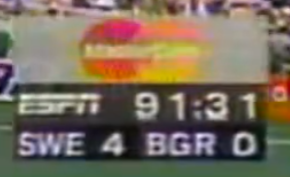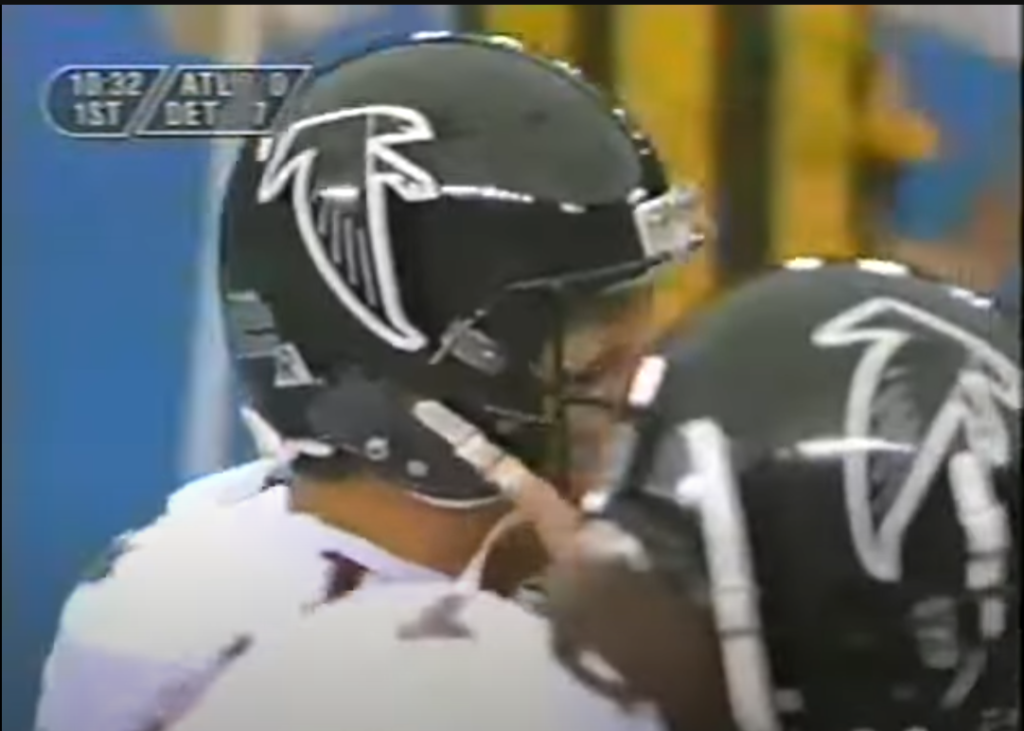1994: A Year That Revolutionized Sports Coverage Forever
30 years ago, during the great broadcast realignment, the sports world was turned on its head thanks to a graphic that sits on our screens today.
1994 was a historic year for television:
January 18th – You’re in the Super Bowl, Charlie Brown would be broadcast by NBC. The last special in Charles Schulz’s lifetime to air on television. It was watched by 7.5 million households.
January 23rd – CBS broadcasts its last NFL game until 1998. The NFL would move to FOX on a $1,580,000,000 deal signed back in December of 1993. Pat Summerall and John Madden are made the A-Crew as they sign lucrative contracts with them.
February 1st – Encore launches 7 multiplex channels on TCI cable systems.
February 23rd – Thanks to the attack on Nancy Kerrigan by Tonya Harding. CBS’s coverage of the women’s short program in figure skating at the 1994 Lillehammer Olympic Games becomes one of the highest rated primetime programs in American history.
March 15th – As part of their deal with FIFA to host the 1994 FIFA World Cup, Major League Soccer signs their first television rights deal with ESPN and ABC Sports despite having no teams, players, coaches, or stadiums
April 3rd – Charles Kuralt hosts CBS Sunday Morning for the final time.
April 14th – Turner Classic Movies debuts
May 23rd – New World Communications signs affiliation agreement with FOX Networks. In turn, News Corporation buys a 20% stake in New World. The deal calls for all stations via New World Communications to switch to Fox. Part 1 of the realignment of 1995
June 16th – ABC dumps KTVK and WJZ after Scripps-Howard Broadcast signs an affiliation pact. KTVK had 40 years with ABC, WJZ? 47 years.
June 17th – The FIFA World Cup is held in America for the first time and many other major sporting events are happening as a major news event is unfolding.
July 14th – CBS buys Westinghouse, which means all Group W broadcasters are purchased and become CBS affiliates. Part 2 of the realignment of 1995.
August 12th – The NFL on FOX debuts with a preseason game between San Francisco and Denver.
September 4th – Fox NFL Sunday debuts
September 9th – NHL signs a 5-year, $155,000,000 contract with Fox.
September 22nd – The Pilot Episode of Friends debuts on NBC
November 28th – The $10,000 wedge debuts on Wheel of Fortune.
December – The great realignment begins for U.S. television and would be completed by January 1, 1995.
You know, sports as it was then in 1993 and earlier had nothing on their screens until it was commercial time, you had to wait until a commercial to find out the score of a baseball, football, hockey, or basketball game. See, at the time, this was compatible with these sports because there was really no need for it but however, there was one person by the name of David Hill (who was head of Sky Sports at the time) who was getting angry of having to wait until a commercial break just to see the current score of a soccer match.
David Hill, who was an innovator, created a scoring bug in August 1992 that kept viewers informed of the game score and the current time during the newly formed Premier League matches. However, there was someone who was quite angry at this move and it was Hill’s boss. Hill’s boss demanded that the bug be taken down at once (calling it the “Stupidest thing he’s ever seen”) but Hill defied his order, kept it there, and thus it became standard practice as the British Broadcasting Corporation put one up in 1993 and then ITV followed for the 1993-1994 season. Fans didn’t complain one bit as it kept them abreast of the time (current and then stoppage), and the score.
As the FIFA World Cup took place in the United States for the first time ever and the common practice was to wait until a television commercial break to wait for the score. This was a problem with the FIFA World Cup due to the constant action of the game and it was long considered incompatible to do. So ESPN sports decided to introduce David Hill’s innovation with a scoring bug with current score, a sponsor, and the count-up clock. Initially, people were confused by the graphic, and television companies didn’t like it because they thought it was “foreign.”
However in football and basketball games, sometimes there would be a graphic for a clock that would stay up for the remainder of a game and people didn’t mind that. But a scoreboard!? Sports fans alike said: “Ok that’s cool, let’s see how this works.”

But understand this, soccer games have constant action at all times going on and cutting into a game for a commercial break isn’t right. There was a plan after the U.S. was awarded the FIFA World Cup to allow for somewhat of an “Americanization” of the game as television advertisers begged to FIFA to allow for the following changes to the game:
1. 4 quarters of 22 minutes and 30 seconds to allow for breaks in between for players (constituting a full 90 minutes of a game without stoppage time) to get water, rest, and so on. This allowing for a few commercials before the next quarter of play began.
2. Unrestricted and unlimited substitutions, stopping time, and allowing for quick 30-second advertising breaks.
FIFA said no to these ideas. The U.S. Television advertisers said: “HUH!? THAT’S NOT FAIR!”
Therefore, ESPN created a score bug to keep viewers informed of the score and also would have “advertiser” credits on the new graphic as “sponsorship” seen above. These score bugs became standard practice but without the advertisements at times.
NFL on FOX debuts and welcomes “The FoxBox”
FOX, a young go-getter network that was just barely getting started (only was 9 years old at the time when it first began in 1984), shocked the big three of NBC, ABC, and CBS by winning the rights to air the National Football Conference football games of the NFL by paying the league an unheard of amount of $1.58 billion.
FOX was long known for living mostly off of their primetime showings and kids shows but they were ready to show the rest of the world that they were going to go on top of the sports world. There was so much skepticism that the NFL had to assure the big three that Bart Simpson wasn’t going to be an announcer. CBS, NBC, and ABC executives must’ve been laughing their boots off but little did they know that this was big news for the NFL. Thanks to FOX’s payment of the rights, the NFL’s newly established salary cap was advanced from the initial $32,000,000 to $34,608,000 per team.
The NFL on FOX debuted with a preseason game between the San Francisco 49ers and Denver Broncos. FOX’s broadcast was a smash hit owing to “futuristic” graphics, sound, and also the hiring of broadcasting legends of Pat Summerall and John Madden.
CBS couldn’t believe they lost the rights because they thought that their promotional opportunities, showings, and advertising prowess but it was at the detriment of themselves because they undervalued the rights.
FOX got smart and creative and brought in David Hill, from aforementioned Sky Sports, to beef up their sports department and to get creative with the brand new pre-game show, FOX NFL Sunday. Hill quickly hired James Brown from CBS, then brought in Howie Long, Terry Bradshaw, and Jimmy Johnson to head up the show. It was an immediate hit with the football crowd with their in-depth coverage of the game, gimmicks, banter, and “love of the game” mentality.
Hill decided to bring in young hip broadcasters like Kenny Albert, Thom Brennaman, Joe Buck, and Kevin Harlan to act as play-by-play men.
Remember how Hill was pestered about the “score bug” graphic for soccer games? Well, he introduced a permanent fixture to the game by adding that same scoreboard to the NFL on FOX broadcasts during a game between Detroit and Atlanta.

Dick Ebersol of NBC was absolutely opposed to the idea of a scoring graphic because he thought that fans would dislike seeing more graphics on the screen but at the same time, would also change the channel if it was a blowout game.
Well I hate to say this, Dick, but nobody wants to wait until the announcer says or when the commercial break comes around just to hear the score of a game in progress. The concept caught on across the sports landscape and now sits as standard practice.
Personally, I enjoy the graphics of a sporting event because it pushes us forward into the future of sports coverage. NBC, FOX, and CBS will generally change their scoring graphics every 3 years to “get with the times” much like how ice cream floats became a thing back in the day because of soda pop shops having “bigger, fancier” soda fountains.
1994 was definitely a definitive and revolutionizing year for sports and today’s sports coverage is still changing year-to-year.






